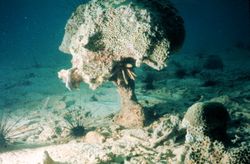Coral reefs are in danger of getting extinct. The greedy man’s ever increasing hunger will one day bring death to the most beautiful oceanic organisms. It is estimated that about 60% of the world’s reefs are at risk due to destructive, human-related activities.
 Coral reefs are calcareous structures produced by living organisms, found in shallow, tropical marine waters with little to no nutrients in the water. And the addition of nutrients favors species that disrupt the balance of the reef communities, such as algae.
Coral reefs are calcareous structures produced by living organisms, found in shallow, tropical marine waters with little to no nutrients in the water. And the addition of nutrients favors species that disrupt the balance of the reef communities, such as algae.
But, human activity continues to represent the single greatest threat to coral reefs living in Earth’s oceans. Areas that used to be full of coral become deserts, full of coral rubble, and dead fish. The biggest threat comes from pollution and over- fishing. Millions of people are dependent on coral reef fisheries. And most of the fish are captured with sodium cyanide, a toxic chemical that dissolves in sea water and released into fish shelters. It has a rapid narcotic effect on fish, which are then easily captured. This in turn affects the coral reefs which are home to innumerable sea creatures such as tropical or reef fishes, sponges, jellyfish, worms, crustaceans, shrimp, crabs, molluscs , starfish, sea urchins, and many more.
 Physical destruction of reefs due to boat and shipping traffic is also a problem. The loss of wetlands and mangrove habitats are considered to be significant factors affecting water quality on inshore reefs. Polluted water encourages the spread of infectious diseases among corals. Dynamite fishing is another extremely destructive method that fishermen use to harvest small fish. First it kills the fish instantly and then the corals. This has a long lasting impact on the corals as it eliminates the very structure of the reef, destroying the habitat for fish and other animals important for the maintenance of a healthy reef. Moreover, El Nino and global warming can cause coral bleaching too.
Physical destruction of reefs due to boat and shipping traffic is also a problem. The loss of wetlands and mangrove habitats are considered to be significant factors affecting water quality on inshore reefs. Polluted water encourages the spread of infectious diseases among corals. Dynamite fishing is another extremely destructive method that fishermen use to harvest small fish. First it kills the fish instantly and then the corals. This has a long lasting impact on the corals as it eliminates the very structure of the reef, destroying the habitat for fish and other animals important for the maintenance of a healthy reef. Moreover, El Nino and global warming can cause coral bleaching too.
It is estimated that 284,300 sq km of tropical coral exist globally and that about 20 per cent have been irreversibly lost in recent decades. Another 26 per cent is at risk. If the commercial exploitation of tropical corals continues at present rates, many reefs will be irreversibly degraded and millions of people will have to look for other sources of food. Or it would require an additional area of tropical coral amounting to 75,000 sq km – 3.7 times the size of the Great Barrier Reef – to make current fishing levels sustainable.
The Great Barrier Reef along the northeast coast of Australia suffered two mass coral bleaching events in the summers of 1998 and 2002, with up to 90% of corals killed. Indonesia’s coral reefs are located in the heart of the Coral Triangle and have been victim to destructive fishing, unregulated tourism, and bleaching due to climatic changes. The threat to the reefs is particularly strong in Southeast Asia, where an enormous 80% of reefs are considered endangered.
Marine Protected Areas have been introduced in Southeast Asia and elsewhere around the world to attempt to promote responsible fishery management and habitat protection. The same need to be imitated in rest of the areas in danger. Furthermore, a variety of activities, including education, regulation, are under way to protect these reefs. It is our utmost duty to preserve and protect our environment, which is a home to millions of creatures and man has no right to disrupt this ecological balance to meet his selfish ends.
via: INDEPENDENT

